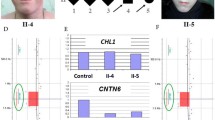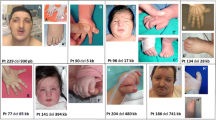Abstract
We have isolated and sequenced cDNAs representing the full-length (2987-bp) gene for dihydrolipoyl succinyltransferase (E2k component) of the humanα-ketoglutarate dehydrogenase comple (KGDHC) from a human fetal brain cDNA library. The E2k cDNA was mapped to human chromosome 14 using a somatic cell hybrid panel, and more precisely to band 14q24.3 by in situ hybridization. This cDNA also cross-hybridized to an apparent E2k pseudogene on chromosome 1p31. Northern analysis revealed the E2k gene to be ubiquitously expressed in peripheral tissues and brain. Interestingly, chromosome 14q24.3 has recently been reported to contain gene defects for an early-onset form of familial Alzheimer's disease and for Machado-Joseph disease. Future studies will be necessary to determine whether the E2k gene plays a role in either of these two disorders.
Similar content being viewed by others
Literature Cited
Nakano, K., Sadayuki, M., yamanaka, T., Tsubouchi, H., Nakagawa, S., Titani, K., Ohta, S., and Miyata, T. (1991). Purification and molecular cloning of succinyltransferase of the ratα-ketoglutarate dehydrogenase complex.J. Biol. Chem. 266:19013–19017.
Nobukuni, Y., Mitsobuchi, H., Endo, F., and Matsuda, I. (1989). Complete primary structure of the transacylase (E2b) subunit of the human branched chain alpha-keto acid dehydrogenase complex.Biochem. Biophys. Res. Commun. 161: 1035–1041.
Cai, X., Szabo, P., Ali, G., Tanzi, R.E., and Blass, J.P., (1994). A pseudogene of dihydrolipoyl succinyltransferase (E2k) found by PCR amplification and direct sequencing of rodent-human cell hybrid DNAs (In press).
Schellenberg, G.D., Bird, T.D., Wijsman, E.M., Orr, H.T., Anderson, L., Nemens, E., White, J.A., Bonnycastle, L., Weber, J.L., Alonso, M.E., Potter, H., Heston, L.L., and Martin, G. (1992). Genetic linkage evidence for a familial Alzheimer's disease locus on chromosome 14.Science 258:668–671.
St. George-Hyslop, P.H., Haines, J., Rogaev, E., Mortilla, M., Vaula, G., Pericak-Vance, M., Foncin, J.-F., Montesi, M., Bruni, A., Sorbi, S., Rainero, I., Pinessi, L., Pollen, D., Polinsky, R., Nee, L., Kennedy, J., Macciardi, F., Rogaeva, E., Liang, Y., Alexandrova, N., Lukiw, W., Schlumpf, K., Tanzi, R., Tsuda, T., Farrer, L., Cantu, J-M., Duara, R., Amaducci, L., Bergamini, L., Gusella, J., Roses, A., and Crapper-McLachlan, D. (1992). Genetic evidence for a novel familial Alzheimer's disease locus on chromosome 14.Nature Genet. 2:330–334.
Van Broeckhoven, C., Backhovens, H., Cruts, M., De Winter, G., Bruyland, M., Cras, P., Martin, J.-J. (1992). Mapping of a gene predisposing to earlyonset Alzheimer's disease to chromosome 14q24.3.Nature Genet.,2:334–339.
Mullan, M., Houlden, H., Windelspecht, M., Fidani, L., Lombardi, C., Diaz, P., Rossor, M., Crook, R., Hardy, J., and Crawford, F. (1992). A locus for familial Alzheimer's disease on the long arm of chromosome 14, proximal to the alpha-1-antichymotrypsin gene.Nature Genet. 2:340–342.
Takiyama, Y., Nishizawa, M., Tanaka, H., Kawashima, S., Sakamoto, H., Karube, Y., Shimazaki, H., Soutome, M., Endo, K., Ohta, S., Kagawa, Y., Kanazawa, I., Mizuno, Y., Yoshida, M., Yuasa, T., Horikawa, Y., Oyanagi, K., Nagai, ?., Kondo, T., Inuzuka, T., Onodera, O., and Tsuji, S. (1993).Nature Genet.,4:300–304.
Blass, J.P., and Gibson, G.E. (1991). The role of oxidative abnormalities in the pathophysiology of Alzheimer's disease.Rev. Neurol. (Paris) 147:513–525.
Blass, J.P., and Sheu, K.-F.R. (1990). energy metabolism in disorders of the nervous system.Rev. Neurol. (Paris) 144:543–563.
Blass, J.P. (1994). Pathophysiology of the Alzheimer syndrome.Neurology 43:Suppl. 4, 535–538.
Blass, J.P. (1994). Metabolic alterations common to neural and non-neural cells in Alzheimer's disease.Hippocampus 3:45–54.
Perry, E.K., Perry, R.H., Tomlinson, B.E., et al. (1990). Coenzyme-A acetylating enzymes in Alzheimer's disease: Possible cholinergic “compartment” of pyruvate dehydrogenase.Neurosci. Lett. 18:105–110.
Sheu, K.-F.R., Kim, Y.-T., Blass, J.P., and Weksler, M.E. (1985). An immunochemical study of the pyruvate dehydrogenase deficit in Alzheimer's disease brain.Ann. Neurol. 17:444–449.
Yates, C.M., Butterworth, J., Tennant, M.C., and Gordon, A. (1990). Enzyme activities in relation to pH and lactate in post-mortem brain in Alzheimertype and other dementias.J. Neurochem.,55:1624–1630.
Gibson, G.E., Sheu, K.-F.R., Blass, J.P., et al. 1988). Reduced activities of thiamine-dependent enzymes in the brains and peripheral tissues of patients with Alzheimer's disease.Arch. Neurol. 45:836–840.
Butterworth, R.F., and Besnard, A.-M. (1990). Thiamine-dependent enzyme changes in temporal cortex of patients with Alzheimer's disease.Metabol. Brain Dis.,5:179–184.
Mastrogiacomo, F., Bergeron, C., and Kish, S.J. (1994). Brainα-ketoglutarate dehydrogenase activity in Alzheimer's disease.J. Neurochem. (in press).
Kalaria, R.N., and Harik, S.I. (1992). Carnitine acetyltransferase activity in the human brain and its microvessels is decreased in Alzheimer's disease.Ann. Neurol. 22:583–586.
Kish, S.J., Bergeron, C., Rajput, A., et al. (1992). Brain cytochrome oxidase in Alzheimer's disease.J. Neurochem. 59:776–779.
Brown, G.G., Levine, S.R., Gorell, J.M., et al. (1989). In vivo31P-NMR profiles of Alzheimer's disease and multiple subcortical infarct dementia.Neurology 39:1423–1427.
Jagust, W.J., Friedland, R.P., Budinger, T.F., et al. (1988). Longitudinal studies of regional cerebral metabolism in Alzheimer's disease.Neurology 38:900–912.
Hoyer, S. (1991) Abnormalities of glucose metabolism in Alzheimer's disease.Ann. N.Y. Acad. Sci. 640:53–58.
Sims, N.R., Bowen, D.M., Neary, D., and Davison, A.N. (1983). Metabolic processes in Alzheimer's disease: Adenine nucleotide content and production of14CO2 from [U-14C]glucose in vitro in human neocortex.J. Neurochem. 41:1329–1334.
Sim, N.R., Finegan, J.M., Blass, J.P., et al. (1987). Mitochondrial function in brain tissue in primary degenerative dementia.Brain Res. 436:30–38.
Sheu, K.-F.R., Cooper, A.J.L., Koike, K., Koike, M., Lindsay, J.G., and Blass, J.P. (1994). Abnormality of theα-ketoglutarate dehydrogenase complex in fibroblasts from familial Alzheimer's disease.Ann. Neurol. 35:312–318.
Gerhard, D.S., Kawasaki, E.S., Bancroft, F.C., and Szabo, P. (1981). Localization of a unique gene by direct hybridization in situ.Proc. Natl. Acad. Sci. U.S.A. 78:3755–3759.
Author information
Authors and Affiliations
Rights and permissions
About this article
Cite this article
Ali, G., Wasco, W., Cai, X. et al. Isolation, characterization, and mapping of gene encoding dihydrolipoyl succinyltransferase (E2k) of humanα-ketoglutarate dehydrogenase complex. Somat Cell Mol Genet 20, 99–105 (1994). https://doi.org/10.1007/BF02290679
Received:
Issue Date:
DOI: https://doi.org/10.1007/BF02290679




